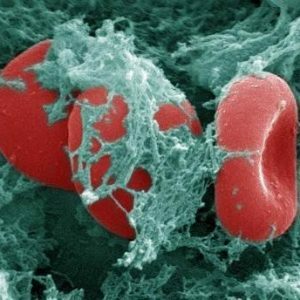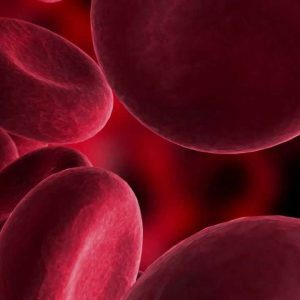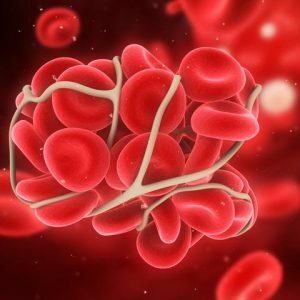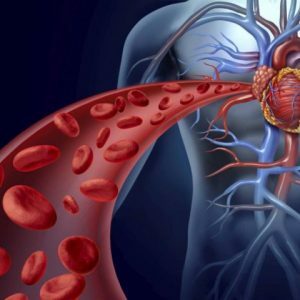Thrombophilia

Thrombophilia is a disorder associated with impairment of the normal functioning of blood vessels and blood clotting indicators, characterized by an increased risk of thrombus formation.Progression of the pathological process and the lack of adequate medical care is fraught with the development of numerous dangerous complications and even the death of the patient!
Note : thrombophilia is a common pathology.According to statistics, this disease affects about 40% of the world's population!
In this case, the processes of normal blood clotting themselves are violated, and in order to prevent possible bleeding, the body thickens the blood, which, in fact, leads to the process of thrombosis.
The insidiousness and danger of ailment lies in the fact that the patient for a long time does not know about his problem and seeks help from a doctor only at the late stages of the pathological process, with manifestations characteristic of thrombosis.
Table of contents: Types of thrombophilia What triggers the development of pathology?Features of thrombophilia in pregnant women Symptoms of thrombophilia What is the danger of pathology?Diagnostic measures Treatment of thrombophiliaTypes of thrombophilia
According to the existing classification, specialists distinguish two types of thrombophilia:
- primary - is caused by hemostasis disorders due to insufficient or, on the contrary, excessively elevated values of blood coagulability;
- secondary - due to disorders of cellular structures that make up the blood.
Important ! Thrombophilia, as a rule, proceeds in a chronic form.Clinical signs are manifested in the period of exacerbation of the disease, and it is important to be able to identify them at the earliest stages of the pathological process!
What triggers the development of pathology?
The causes of thrombophilia are very diverse.
According to the doctors, the following factors may provoke the development of thrombophilia:
- genetic predisposition;
-
 pathology of the hematopoietic and circulatory systems, blood diseases, cardiac malformations, erythremia;
pathology of the hematopoietic and circulatory systems, blood diseases, cardiac malformations, erythremia; - traumatic vascular injuries and patient-induced surgical interventions;
- prolonged and uncontrolled use of some medications;
- hepatic disease;
- heart attacks and strokes, cardiovascular pathologies;
- varicose disease;
- course of chemotherapy;
- inflammatory processes;
- sedentary lifestyle, inadequate motor activity;
- chicken pox.
Important ! To provoke the development of thrombophilia in the fair sex can long-term use of hormonal contraceptives, not prescribed by the doctor!
The reasons for the development of thrombophilia are largely related to the fact that it is a congenital pathology or acquired.
In congenital disease, the disruption of normal hemostasis is due to the presence in the body of specific genes that are inherited and lead to clotting disorders.
Acquired thrombophilia can develop as a complication after the patient has undergone diseases such as diabetes mellitus, pneumonia, thrombocytosis, autoimmune and oncological processes.
Features of thrombophilia in pregnant women
 Quite often thrombophilia occurs in women during the waiting period of the baby.Typically, this is due to the genetic predisposition of the patient to thrombophilia, and the mechanism of the pathological process is triggered as a result of certain changes in the physiological nature that occur in the body of the future mother.
Quite often thrombophilia occurs in women during the waiting period of the baby.Typically, this is due to the genetic predisposition of the patient to thrombophilia, and the mechanism of the pathological process is triggered as a result of certain changes in the physiological nature that occur in the body of the future mother.
The placental circle of blood circulation exerts additional stress, in addition, a woman expecting a baby has an increase in the coagulability of the blood( this way the body is protected from the development of uterine bleeding during labor).All these factors can provoke thrombophilia in a pregnant woman!
Important ! During pregnancy, the risk of thrombosis, according to physicians, increases many times.Therefore, a future mother with diagnosed trophophilia should be especially cautious, she should be under the strict supervision of a specialist.
The development of thrombophilia during pregnancy is fraught with the development of such dangerous complications as miscarriage, placental detachment, eclampsia, premature onset of the birth process and the appearance of a premature or dead baby.
In order to avoid undesirable consequences, the patient needs to undergo a complete therapeutic course aimed at eliminating the characteristic painful symptoms and preventing the development of possible complications!
Symptoms of thrombophilia
Thrombophilia is characterized by a smooth, gradual development, therefore, a long time can proceed almost asymptomatically.
However, the following general clinical features are typical for this pathology:
- edema;
- development of pain syndrome, pain in the chest that occurs when an inspiration is performed;
- rapid pulse( tachycardia);
- cough with discharge of bloody sputum and difficulty in respiratory function, development of dyspnea;
- numbness of the lower limbs;
- increased fatigue, weakness and general malaise;
- headaches;
- slowed mental reactions.
It should be noted that in most cases, all of the above symptoms fail in the patient as a result of the formation of a thrombus.
Note: brightness of painful symptoms in thrombophilia depends on the size of the thrombus, its location and the effect on the total blood flow!
In any case, if you identify any clinical signs that indicate the presence of thrombophilia, you urgently need to contact an specialist.Complex diagnostics and adequate treatment will help to avoid further progression of the pathological process, the development of concomitant diseases and various complications.
What is the danger of pathology?
Thrombophilia is an extremely dangerous pathology.It may well cause a sudden death of the patient even at the youngest age!
Among the most common complications that can cause disease, special attention should be paid to:
-
 infarct;
infarct; - stroke;
- pulmonary thromboembolism;
- thromboses;
- ischemia;
- cerebral hemorrhage;
- peritonitis;
- intestinal necrosis;
- development of gangrene.
Important ! A fractured thrombus sometimes causes a rapid lethal outcome, without manifestation of any painful symptoms.That is why thrombophilia must be treated, and, the earlier the therapeutic measures are carried out, the higher the chances of achieving favorable results.
Diagnostic measures
For the diagnosis of thrombophilia, doctors prescribe the following types of studies to patients:
- laboratory blood test for determination of coagulation rates;
- ultrasound examination of blood vessels;
- radiography;
- a venographic study;
- contrast contrast arteriography;
- computer and magnetic resonance imaging.
This comprehensive diagnosis allows not only to detect the presence of thrombophilia, but also to establish the size of thrombi, their localization.And this will help to designate the most effective therapeutic course optimal for a particular patient!
Treatment of thrombophilia
At the initial stages of the pathological process for the control of thrombophilia, the methods of drug therapy are used.
In most cases, the treatment course includes the administration of such medications :
-
 preparations-disaggregants;
preparations-disaggregants; - anticoagulants, whose action is aimed at preventing the formation of thrombi;
- preparations are fibrinolytic in nature, which are injected directly into the area of the affected and clogged thrombus vessel;
- medications that promote vascular wall strengthening;
- preparations of folic acid( used for congenital thrombophilia due to genetic factors, for the prevention of thrombosis).
Note: has a good therapeutic effect for thrombophilia, giving the procedure for transfusion of donor blood or blood plasma, as well as thrombocytophoresis.
Diet therapy
An important role in the fight against trobophilia is played by adherence to the therapeutic diet recommended to the patient by the attending physician.
In order to prevent further thrombosis, patients should be excluded from their daily diet the following foods with high cholesterol content:
- fatty meat and fish varieties, animal fats;
- by-products, lard, milk, liver;
- fried food and fatty foods, strong broths;
- chocolate, coffee;
- beans;
- cheeses of firm grades.
The menu of the patient with thrombophilia is recommended to enrich as much as possible with such useful products:
- fruit;
- greens, fresh vegetables.
- raisins, dried fruits, dried apricots;Cranberries, grape juice,
- ;
- sea kale;
- ginger;
- seafood;
- cereals.
Important !For the normalization of blood coagulability in thrombophilia, it is important to observe the correct drinking regime, consuming at least 2.5 liters of liquid during the day( preference should be given to clean water, herbal teas and decoctions, compotes from dried fruits).
Additional recommendations
Increase the effectiveness of thrombophilia treatment and accelerate the recovery process if the patient strictly adheres to the following recommendations of :
- to massage the affected areas;
- take daily walks in the fresh air;
- to swim( in pools and reservoirs);
- to engage in exercise therapy;
- strictly follow the prescription of the doctor regarding nutrition, daily regimen and medication;
- use elastic bandages;
- wear compression lingerie;
- to avoid heavy lifting;
- to lead a mobile lifestyle, but at the same time try to be less in a standing position.
Preventative measures
To avoid the development and recurrence of thrombophilia, patients should follow the preventive recommendations:
-
 to lead a lively lifestyle and engage in sports;
to lead a lively lifestyle and engage in sports; - is right, balanced to eat, reducing to the minimum levels the content in the daily diet of fatty, smoked and fried foods;
- undergo regular preventive examinations with specialists;
- to fight overweight;
- avoid overheating and general hypothermia of the body;
- not to take hormonal preparations( including contraceptives) without the appointment of a doctor;
- monitor blood pressure and cholesterol levels.
Important! During pregnancy planning, the expectant mother needs to undergo a comprehensive medical examination, including the determination of platelet counts and the exclusion of thrombophilia.When detecting this disease, a full therapeutic course is recommended even before the conception of the baby!
Successful fight against thrombophilia should be of a complex nature, including the methods of exercise therapy, adherence to the principles of dietary nutrition, physiotherapy and medical therapy.Only with this approach it is possible to achieve stable positive results of treatment, avoiding the development of characteristic complications and possible relapses of the disease!
Betsik Julia, doctor, medical reviewer



